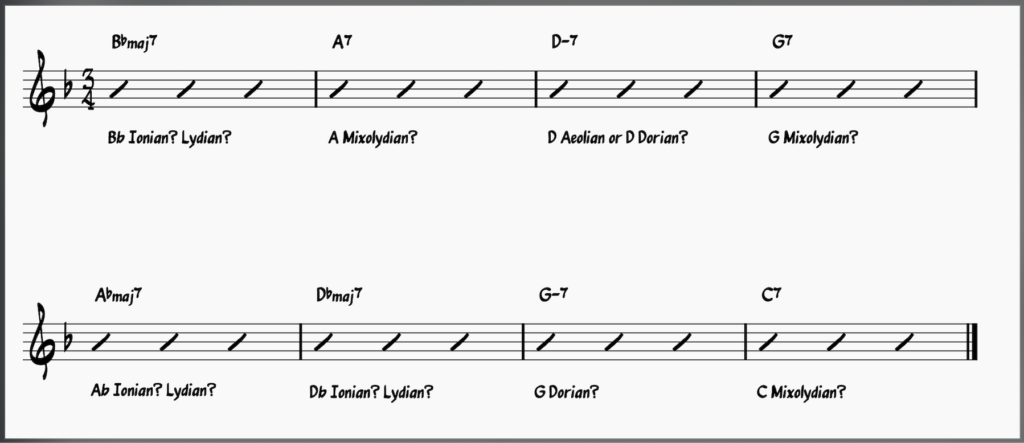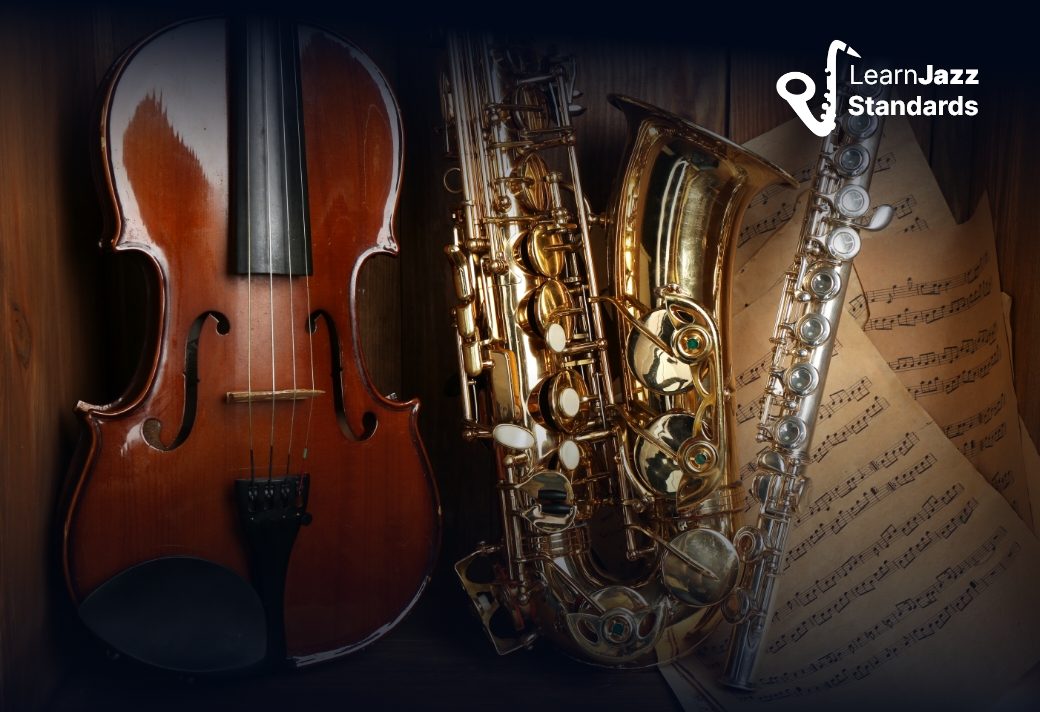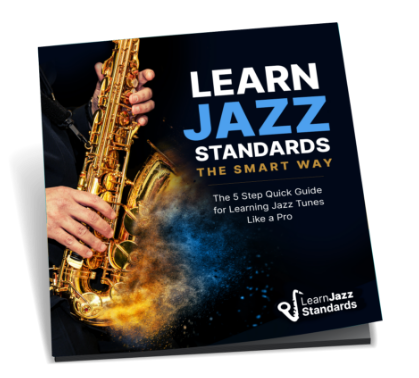How often do you ask, “What are modes in music?” Maybe you are new to musical modes, or perhaps you are familiar with them but want to deepen your understanding of them.
If either is true, then you will want to read this post.
Any music student will eventually encounter modes. A strong command of the musical modes is essential if you aim to be fluent in the language of jazz.
You should be able to understand modes theoretically and have a solid command of the seven modes on your instrument. This article will serve as the playbook for understanding modes in theory and practice.
By the end of this post, you’ll—
- Know the modes of the major scale
- Understand the relationship between modes and chords in major keys
- Understand different ways to think about modes
- Have actionable ways to practice and apply the modes to improve your jazz playing
Whether you are new to the concept or have a decent understanding of modes already, the practice tips and perspectives in this post should help you think about modes in new ways and give you exercise to try in the practice room.
Speaking of practice rooms, if you want to join an avid community of jazz musicians and are serious about improving your jazz chops, check out the Learn Jazz Standards Inner Circle. You’ll learn essential skills for practicing smarter and making measurable progress.
Join the Inner Circle and improve your playing in 30 days or less.
Let’s dig in.
Table of Contents
Is a Mode a Scale?
According to its most basic definition, a mode is simply a scale. But there is much more to it than that. A mode is also a tonality, much like the major scale has its own tonality. In fact, the major scale itself is one of the seven modes—called the Ionian mode.
More on that in a bit.
When you play a C major scale, the root note C establishes its tonality. All notes that follow are defined according to their relationship to C. As you travel through the scale, you hear C major’s characteristic intervals or relationships to C that give the key its distinct tonality.
We know the C major scale as—
You can also think of it in terms of the steps from one note to another. In this case, W-W-H-W-W-W-H.
We also know that this scale continues in a repetitive sequence up and down the staff—i.e., scales are sequences that repeat. If C major is this exact sequence of notes from one C to the next C an octave higher, what happens if you started this sequence on D?
Even though the sequence is the same, the step-wise relationships have changed—W-H-W-W-W-H-W
The sequence of notes stays the same, but what we count as the root note changes. Now, all of the notes in this sequence are defined by their relationship to D. This considerably changes the scale’s tonality. We’ve discovered the major scale’s second mode, the Dorian mode.
Here is the essence of modes—each note in the sequence can be considered the root note. Therefore, this one sequence of notes contains seven distinct scales with unique tonalities.
According to this understanding, musical modes organize the distinct tonalities present within the sequence of notes in any parent scale.
This leads to some key takeaways regarding modes—
- There are as many modes of a particular scale as there are notes in the sequence. This is true for scales that have less than seven notes or more than seven notes.
- Though the different modes are all made up of the same sequence of notes as the parent scale, the tonality of each mode is unique because the relationships to the root note depend on where you are in the sequence.
Music Modes Explained: 7 Modes of the C Major Scale
So, what are the seven diatonic modes of the major scale? We’ve already briefly introduced the first two—Ionian and Dorian. We’ll explore them all, but first, a little history lesson.
Where do the modes get their unique-sounding names?
History of Musical Modes
We get our English word mode from the Latin word modus. It had several meanings in Latin, just as it has several meanings or uses in English today. The word took on its musical meaning in the Middle Ages when musicians who worked for the Catholic Church established the foundations of Western music theory.
However, these musicians didn’t choose distinctly Greek names for the modes at random. All seven modes are named after regions of Ancient Greece and can be tied back to Ancient Greek modes. They are as follows—
Ionian Mode (I)
C major scale, or C Ionian mode
- Step sequence: W-W-H-W-W-W-H
- No Alterations: 1-2-3-4-5-6-7-8
- The Ionian mode is more commonly referred to as the major scale. It starts on the first scale degree of C major.
Dorian Mode (ii)
D Dorian scale, the second mode; C major starting on D
- Dorian Mode step sequence: W-H-W-W-W-H-W
- Alterations to the Major Scale: 1-2-b3-4-5-6-b7-8
- The D Dorian scale begins on the second scale degree of C major.
For more on the Dorian mode, check out our guide to the Dorian scale on piano and guitar.
Phrygian Mode (iii)
E Phrygian scale, the third mode; C major starting on E
- Phrygian mode step sequence: H-W-W-W-H-W-W
- Alterations to the Major Scale: 1-b2-b3-4-5-b6-b7-8
- The E Phrygian scale begins on the third scale degree of C major.
Lydian Mode (IV)
F Lydian scale, the fourth mode; C major starting on F
- Lydian mode step sequence: W-W-W-H-W-W-H
- Alterations to the Major Scale: 1-2-3-#4-5-6-7-8
- The F Lydian scale begins on the fourth scale degree of C major.
For more on the Lydian mode, check out our guide to the Lydian scale on guitar and piano.
Mixolydian Mode (V)

G Mixolydian, the fifth mode; C major starting on G.
- Mixolydian mode step sequence: W-W-H-W-W-H-W
- Alterations to the Major Scale: 1-2-3-4-5-6-b7-8
- The G Mixolydian Scale starts on the fifth scale degree of C major.
For more on the Mixolydian mode, check out our guide to the Mixolydian scale on guitar and piano.
Aeolian Mode (vi)
A Aeolian Scale, the sixth mode; C major starting on A
- Aeolian mode step sequence: W-H-W-W-H-W-W
- Alterations to the Major Scale: 1-2-b3-4-5-b6-b7-8
- The Aeolian mode is more commonly referred to as the natural minor scale. The A Aeolian scale starts on the sixth scale degree of C major (and the first scale degree of A minor).
BEFORE YOU CONTINUE...
If music theory has always seemed confusing to you and you wish someone would make it feel simple, our free guide will help you unlock jazz theory secrets.

Locrian Mode (vii)
B Locrian Scale, the seventh mode; C major starting from B
- Locrian mode step sequence: H-W-W-H-W-W-W
- Alterations to the Major Scale: 1-b2-b3-4-b5-b6-b7-8
- The B Locrian Scale starts on the seventh scale degree of C major.
Chord-Scale Relationships in the Major Key—How To Use Music Modes In Improvisation
Now that we understand the musical modes, we can start to piece together how musicians use them improvisationally and compositionally via major and minor scales.
Each of the seven modes is built off of the seven scale degrees of the major scale. What else is built off of the seven scale degrees of the major scale? If you said, “the diatonic chords of the major key,” you’d be correct.
Each mode of the major scale has a corresponding diatonic chord.
Using The Modes Over a Chord Progression in Music Theory
If you (1) know the key of the tune and (2) can figure out what scale degree of the major scale that chord is built from, you know which mode you can use over that chord.
For example, let’s take a simple chord progression that appears in many, many jazz tunes—a I-vi-ii-V in the key of F.
- Fmaj7 is the (I) chord, so we’ll use F Ionian in bar 1
- Dm7 is the (vi) chord, so we’ll use D Aeolian in bar 2
- Gm7 is the (ii) chord, so we’ll use G Dorian in bar 3
- C7 is the (V) chord, so we’ll use C Mixolydian in bar 4

Sure, you could play ideas in F, and those ideas will likely work to a degree. However, if you were to use the correct modes, you’d naturally emphasize chord tones (in red) on the down beats and utilize the tonality of the modes to create more convincing lines.
In the 8th note-heavy jazz idiom, modes are a powerful tool to convey the harmony of the moment.
Different Ways of Thinking About (And Using) Modes in Music Theory and Practice
It can be difficult to perform mental math to find the right mode in the heat of the moment, especially on fast tunes with chord changes every two beats, like jazz music.
That begs the question, “What’s the best way to think about modes?” Many jazz musicians have varied opinions regarding the correct answer.
Some will tell you that you should always think of the modes as separate entities and never think of them as related to tonal centers. Others will insist that you think of modes as they relate to their parent key.
- The first camp would say that it’s easier to think of C Dorian by the numbers—1-2-b3-4-5-6-b7-8.
- The second camp belongs to the parent scale method. They would insist you should consider C Dorian as a Bb major scale starting on C. In this case, you are considering the Dorian mode as it relates back to its parent scale.
I think this is a false dichotomy.
To learn how to use modes proficiently, you will have to put in the work and do math regardless of which way you think about it. It’s probably most beneficial to understand the benefits of seeing modes both ways.
The first method helps you quickly manipulate or alter the major scale to get the sound you need. The second method helps you consider the context of the mode in terms of the parent scale.
How to Practice the Modes
Now that you have a solid understanding of the seven modes, how they are used, and why they are important, let’s explore different ways of practicing them. There are many ways to do this, and to be a well-rounded musician, it’s a good idea to try to practice them in as many different ways as possible.
After practicing the modes in one key, the following exercises are intended as the next step. Keep the metronome on 2 and 4 to practice a good jazz feel!
Exercise 1: From the Same Root
Sometimes, when you practice all the modes in one key, the tonality of each mode can get lost in the prominence of the major key tonality. That’s why practicing all the modes from the same root note is beneficial.
Instead of playing all the modes in the key of C:
- C Ionian mode
- D Dorian mode
- E Phrygian mode
- F Lydian mode
- G Mixolydian mode
- A Aeolian mode
- B Locrian mode
Practice all the modes with C as the root. It’s beneficial to use a drone note for this exercise.
- C Ionian mode (key of C)
- C Dorian mode (key of Bb)
- C Phrygian mode (key of Ab)
- C Lydian mode (key of G)
- C Mixolydian mode (key of F)
- C Aeolian mode (key of Eb)
- C Locrian mode (key of Db)
Practicing music modes in this way allows you to hear the tonality of each musical mode from the same root pitch and prevents the modes from getting lost in the tonality of the parent key. Plus, relating the mode back to the key you are playing in (C Aeolian being the key of Eb, for example) is a great way to enrich your understanding of music theory.
Exercise 2: Moving in Intervals
Pick one musical mode for this exercise and move it up or down different intervals. For example, take the Dorian mode and start on C. Let’s move the Dorian mode up in major second intervals until we return to C.
- C Dorian (key of Bb)
- D Dorian (key of C)
- E Dorian (key of D)
- F# Dorian (key of E)
- Ab Dorian (Key of Gb)
- Bb Dorian (Key of Ab)
- C Dorian (Key of Bb)
This exercise helps you hear how a mode translates through different tonal centers (or keys). Many jazz composers have used this concept to help them write modal tunes. Pick a mode and an interval, and pay attention to the sound of the shifting tonal centers.
Exercise 3: Practice Modes Over Jazz Standards
You’ll also want to practice applying modes to jazz standards.

The first four bars of Bill Evan’s Waltz For Debby are all diatonic in the key of F.
When a tune’s tonal centers are clear, it’s fairly easy to determine which modes should be used and when. For example, the first four chords in Waltz for Debby are I-vi-ii-V in F.
But what do you do when the tonal centers aren’t so apparently clear? Take the last 8 bars of the B section from Waltz For Debby.

You can almost make the modes of the major scale work here, but it isn’t always a perfect fit. This tune requires the use of modes outside of the major scale.
We’re going to need more options to play over this harmony.
What Are Modes Beyond the Major Scale? Melodic Minor (Jazz Minor)
Once you feel comfortable with the modes of the major scale, you’ll want to start exploring modes from other scales to truly bring out the color in jazz harmony. The melodic minor (Jazz Minor) scale is made up of so many essential jazz modes.

- Melodic Minor Scale (i)
- Dorian b2 (ii)
- Lydian Augmented (iii)
- Lydian Dominant (IV)
- Mixolydian b6 (V)
- Half-Diminished (vi°)
- Altered Scale (vii°)
Check out our blog post on the melodic minor scale and its modes to level up your jazz playing and increase your scale knowledge. Plus, check out our blog post on the 16 most important scales for jazz.
Ready To Take Your Jazz Playing To The Next Level?
If you want to take your jazz playing to the next level but feel like you aren’t progressing in the practice room, check out the Learn Jazz Standards Inner Circle.
There are so many wrong ways to practice.
The Learn Jazz Standards Inner Circle will grant you access to—
- Monthly jazz standard studies to help you learn and improvise over jazz standards
- In-depth courses, practice programs, and personalized plans to help you improve quickly
- Instrument Accelerator courses to help you master your instrument.
- A diverse community of musicians who love jazz like you do.
What are you waiting for? Check us out.









